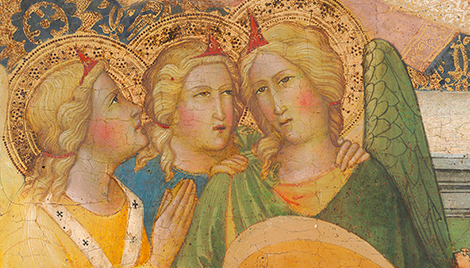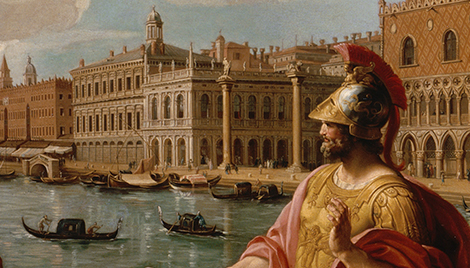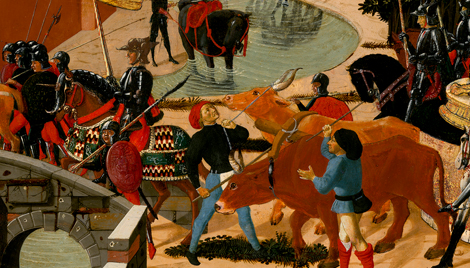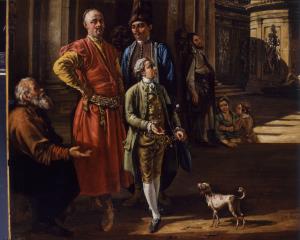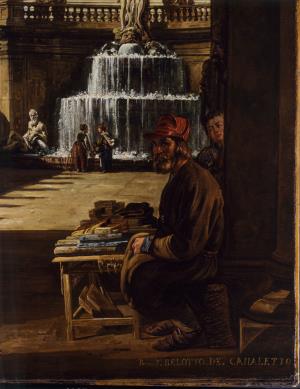Entrance to a Palace or Architectural Capriccio with a Portrait of Voivod Franciszek Salezy Potocki
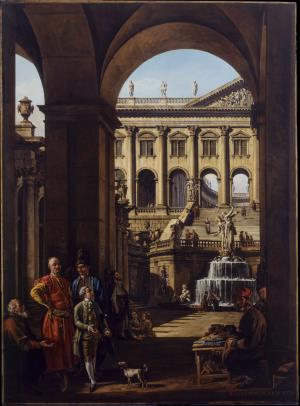
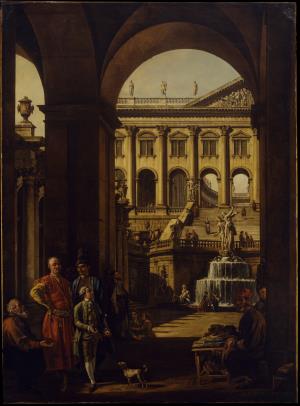
Entrance to a Palace or Architectural Capriccio with a Portrait of Voivod Franciszek Salezy Potocki
- Artist
- Bernardo Bellotto
- Artist Dates
- 1722-1780
- Artist Nationality
- Italian
- Title
- Entrance to a Palace or Architectural Capriccio with a Portrait of Voivod Franciszek Salezy Potocki
- Date
- c. 1762-65
- Medium
- oil on canvas
- Dimensions
- 153.6 x 113.6 cm (60-1/2 x 44-3/4 in)
- K Number
- K1691
- Repository
- El Paso Museum of Art
- Accession Number
- 1961.1.50
- Notes
Provenance
Sir Robert Philip Wyndham Adeane [1905-1979], Babraham Hall, Cambridge, England; (his sale, Christie's, London, 13 May 1949, no. 31); (Spiller). (David Koetser, New York); sold to Samuel H. Kress [1863-1955] on 13 April 1950; gift to El Paso Museum of Art in 1961, no. 1961.1.50.
Catalogue Entry
Bernardo Bellotto
Entrance to a Palace or Architectural Capriccio with a Portrait of Voivod Franciszek Salezy Potocki
K1691
El Paso, Tex., El Paso Museum of Art (1961-6/42), since 1961.(1) Canvas. 60 1/2 x 44 3/4 in. (153.6 x 113.6 cm.). Signed at lower right: Bernard. BELOTTO. DE. CANALETTO. Very good condition. Both the signature and composition class K1691 with an architectural caprice now in the Nationalmuseum, Warsaw, in which a splendid figure in the costume of a Venetian nobleman has been identified as a portrait of Bellotto himself.(2) The Warsaw picture, along with several other fanciful architectural paintings, is believed to date from Bellotto's late Dresden period. K1691 may be later, after the artist's establishment in Warsaw, in 1767. The figures here are in Polish costume, and the large man with arm akimbo has been identified from an engraving as Count Franciscus Salesius Potocki, while the young man in front may be his son, Stanislaus Felix, fifteen years of age in 1767, who was to become more famous than his father, but as traitor to Poland.(3) A pertinent stylistic parallel to the portraits in K1691 is offered by those in the Election of Stanislaus Augustus, a large canvas in the Nationalmuseum, Warsaw, painted by Bellotto in 1776/78.(4) Aside from K1691 and the painting with the self-portrait referred to above, Bellotto painted a considerable number of architectural caprices, often with compositions very similar to K1691, views through an archway to a monumental stairway and a columned hemicycle beyond, features that would seem to be based on the artist's memories of architecture by such Roman artists as Bernini.(5) In K1691 Bellotto has frankly copied his fountain sculpture from Bernini's Apollo and Daphne. However fanciful his caprices may be, Bellotto usually studied his architecture so carefully from actual buildings that his paintings were followed in the restoration and rebuilding of Warsaw after the Second World War.(6) Provenance: Colonel Robert Adeane, Babraham Hall, Cambridge, England (sold, Christie's, London, May 13, 1949, no. 31, as Bellotto; bought by Spiller). David M. Koetser's, New York. Kress acquisition, 1950 –exhibited: National Gallery of Art, Washington, D.C., 1951-56;(7) Chattanooga Art Association, George Thomas Hunter Gallery of Art, Chattanooga, Tenn., July 12-Aug. 3, 1952, unnumbered p. of catalogue, as Bellotto; after entering the El Paso Museum of Art: 'Art Treasures for America,' National Gallery of Art, Washington, D.C., Dec. 10, 1961-Feb. 4, 1962, no. 5, as Bellotto.
References
(1) Catalogue by F. R. Shapley, 1961, no. 42, as Bellotto. (2) The Warsaw painting is reproduced by T. Borenius, in Dedalo, vol. III, 1922, p. 103. See the recent discussion by W. Schumann, in the catalogue of the Bellotto exhibition in Vienna, 1965, no. 43. The identification of the portrait is noted by S. Lorentz in a letter of Nov. 16, 1955, to W. E. Suida. (3) These identifications were suggested by Lorentz (in the letter cited in note 2, above), who kindly sent to the Kress Foundation a copy of Cunego's engraving of a portrait of Potocki after a painting by Bacciarelli, an Italian painter in Warsaw who encouraged Bellotto to take up residence there. Dr. Lorentz comments that Potocki could have been easily included in a painting by Bellotto, even before the artist came to Poland, since Potocki, with his immense land holdings, had associations with the minister Brühl and was often in Dresden. Cunego's engraving is dated 1781 (or 1782) but Bacciarelli's portrait, Dr. Lorentz comments, was probably painted more than a decade earlier. (4) Details of some of the portraits in the Election ... are reproduced by Lorentz, in catalogue of the exhibition of Bellotto and Gieryrnski, Palazzo Grassi, Venice, 1955, figs. 25a, b, c, d. (5) Several of these are reproduced by H. A. Fritzsche, Bernardo Bellotto, 1936, figs. 73 ff. (6) See Lorentz, p. 9 of op. cit. in note 4, above. (7) Paintings and Sculpture from the Kress Collection, 1951, p. 166 (catalogue by Suida), as Bellotto.

